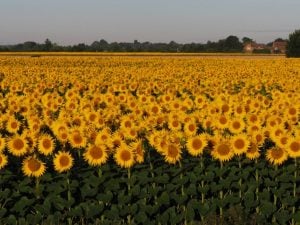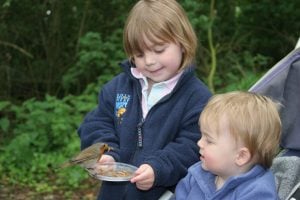How to Feed
It's not just the selection of bird food that is important in determining which species of bird you attract to your garden, but also the type of bird feeder and where feeders are sited.
The following covers the main bird feeder types and other feeding methods:
Hanging Bird Seed Feeders
A hanging bird seed feeder is a must if you want to attract a wide mix of birds. It’s fair to say that the hanging seed feeder filled with the right food will, on its own, attract the greatest number of bird species including: most species of tit (though not long-tailed), Greenfinch, Goldfinch, House and Tree Sparrow and, if the perch is the type shown in this photo, Robins too will feed from it (the ‘platform’ type perch is much easier for them to use than a thin single perch). Perch rings can be added to most of our Droll Yankee Bird Feeders for extra perching stability.
Virtually all our seeds and bird seed mixes can be used in our hanging seed feeders, with the exception of niger seed and our Vine House Farm Ground Mix and Robin and Friends Mix.
How to Choose Bird Seed Feeder
The range of hanging bird seed feeders we stock at Vine House Farm is extensive, and there are many factors to consider when choosing the one which is best for you.
Port Size
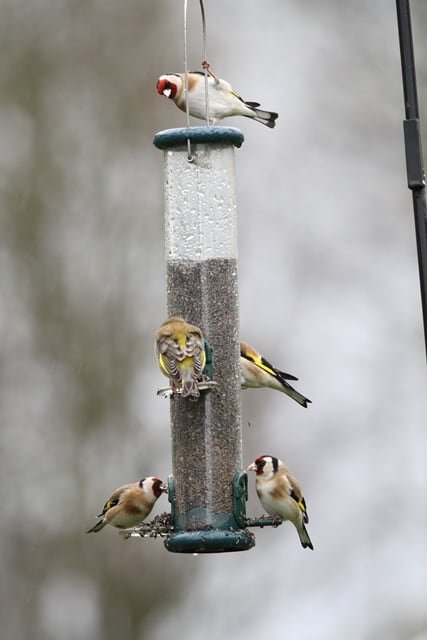
The smallest seed feeder we sell has just two ports, with the largest having 12 ports. The obvious limitation of the small feeder is how many birds can feed at any one time, plus the amount of seed it holds is limited.
In general, we recommend a feeder with at least 4 ports, as anything smaller will inevitably lead to birds fighting to get onto the limited number of ports, therefore wasting their valuable energy.
Material
The tubes of all seed feeders are made of polycarbonate, which is a tough and durable material. For the base, top and port fittings, these are either plastic or metal.
The plastic option is fine and certainly represents good value for money, but if you have squirrels in your garden then definitely go for metal – a grey squirrel can easily damage even a good quality plastic feeder.
Keeping Squirrels Out
We also have some special squirrel proof bird feeders especially designed to keep squirrels off the food. So if squirrels are a real problem in your garden, then these squirrel resistant feeders are a very good option.
Of course, having several seed feeders in your garden not only means more birds can feed at any one time, but also that you can have different seeds and mixes in them and therefore encourage more species.
For example, one feeder might have our black sunflower seeds attracting Greenfinches and Great Tits, with another containing our Ultimate Energy with Suet Bird Seed Mix to attract robins (with the right perch – see above), House Sparrows and Coal Tits.
Niger Seed Feeders
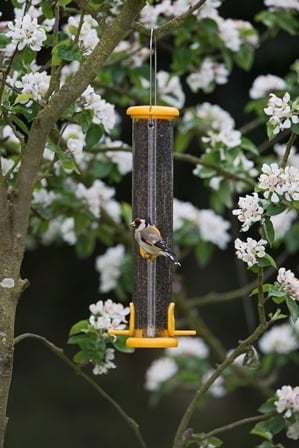
Niger seed feeders are specially designed to hold the tiny niger seed (also alternatively called thistle seed and also sometimes spelt nyjer seed), which, if poured into a normal seed feeder, would simply flow straight out the ports. So the ports in a niger seed feeder are very small holes, which Goldfinches and Siskins – the main two species of bird which eat niger – extract the seed from. Redpolls will also take niger seed from this specialist feeder, though often prefer to feed underneath it on the ground and pick up any seed which Siskins drop.
Like normal seed feeders, niger seed feeders come in various sizes but we always recommend buying the largest version you can. If Goldfinches and Siskins are present in your part of the country, they are very gregarious and if you get one, then chances are ten (or more) are close behind. In addition, because of their relative simplicity compared to normal seed feeders, there isn't that much difference in price between a small and a large niger seed feeder, so the bigger feeders are definitely better value for the money.
Fittings are either plastic or metal, with metal essential if squirrels visit your garden.
Mesh Peanut Feeders
Peanuts should only ever be fed from mesh peanut feeders. The reason being that whole peanuts – either put into a seed feeder, on the ground or bird table – will be eaten whole by some birds and this can lead to them choking and dying. This is a particular problem for Robins. A mesh peanut feeder is completely safe as any bird can only pick relatively small pieces of peanut out of it.
Our suet pellets can also be used in this type of feeder, either on their own or mixed with peanuts.
All the mesh on our feeders is steel, but the top and bottom fittings can be either plastic or metal. Again, if squirrels are in your garden (or are just in the area – putting a peanut feeder up will probably ensure they appear in your garden) then metal is the only option as peanuts are one of their favourite and most irresistible foods. If with a metal peanut feeder, squirrels are still a problem, then we also have several types of mesh peanut feeder which have a cage around them – thus allowing small birds in to feed but keep squirrels out.
Mealworm, Live Food and Soft Food Feeders
Live bird food or mealworm feeders are usually in the form of a covered dish, which allows either the live food – i.e. mealworms or wax worms – or soft food such as Ground Mix and Robin and Friends mix to stay dry and, in the case of live food, prevent it wriggling away!
Ground and Table Feeding
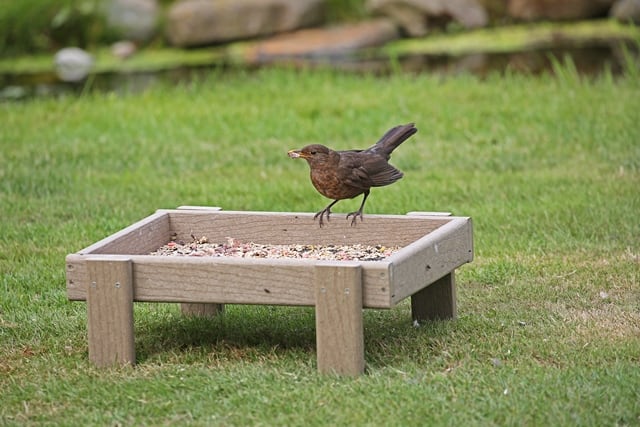
A number of garden birds will not go onto feeders at all, simply because they would principally feed on the ground in natural circumstances. These species include the Blackbird, Song Thrush and Collared Dove. Other species will go onto feeders with the newer style platform perches but are still happier feeding on the ground or a table. These species include the Robin and Dunnock.
Given its flat feeding surface, a bird table provides ground-feeding birds with a good opportunity to feed. In addition, a bird table with a roof keeps food dry in wet weather.
Putting food directly on the ground is an option, but not an ideal one as it can become contaminated if not eaten quickly and can attract rodents. A better option is a ground feeding tray which, to the bird, is effectively the ground, but in reality keeps the food several inches above it.
It’s also a good idea to give birds protection with a ground guard. In addition to giving feeding birds protection from predators, the ground guard also keeps out larger birds such as Wood Pigeons and Jackdaws.
Most foods can be fed on bird tables and on ground feeding trays, but never peanuts which should only ever be fed from a mesh feeder. Also, it’s better to avoid seeds which are still in their husk such as Black Sunflower Seeds, as the husks will soon cause a mess and can quickly become contaminated.
Ideal foods for ground feeders and feeding tables include our Vine House Farm:
- Ground Mix
- Robin and Friends Mix
- Suet Pellets
- Sunflower Hearts
- Won’t Grow Mix
- Ultimate Energy with Suet
- Ultimate Energy with Mealworms
A final word on bird tables: it’s absolutely essential to keep them clean, as harmful bacteria will quickly build up on the feeding surface if uneaten food is allowed to go rotten. We have a range of Hygiene and Cleaning Products to assist you. You can also read our "Feeder Hygiene" guide for more information.
Feeding Stations
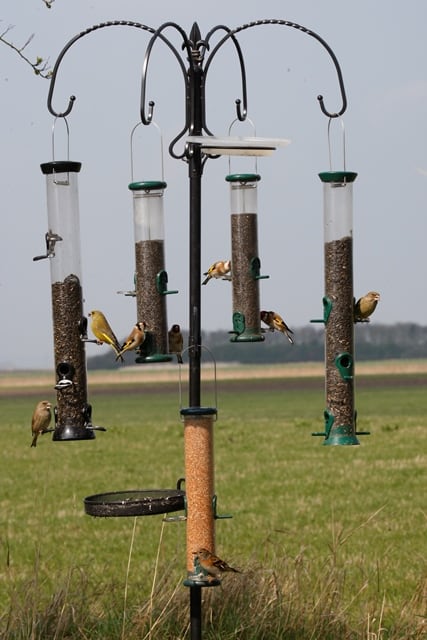
As can be seen in this photo, a bird feeder station allows multiple feeders to be hung together, plus also provides a bowl for water and a small tray for foods such as mealworms.
Advantages of Feeding Stations
Using a feeding station rather than just hanging feeders from branches also has a number of other advantages:
Ideal position in the garden
The feeding station can be placed in an ideal position – e.g. away from predators plus also to allow easy viewing from your window – and not just where a branch happens to be.
Helps prevent disease
Having feeders in one position for a long period of time is definitely not a good thing, as the ground below can become contaminated and this can lead to birds becoming diseased and dying. So a feeding station allows for all the feeders to be moved to new locations in the garden at regular intervals.
Garden birds typically like to feed together
The majority of the birds you attract to your garden will be gregarious and will be happier feeding in groups. And there’s a good reason for this: birds are vulnerable to predators – in particular Sparrowhawks – when they’re feeding because they are both stationary and occupied. So by feeding in groups – which are often of mixed species – there are multiple eyes on the lookout which therefore reduces the risk of being caught. So it’s very much a ‘safety in numbers’ thing.
Bird Feeder Accessories
There are all sorts of accessories to make life easier for both you and your garden birds, with your top suggestions being the following:
Perch Rings
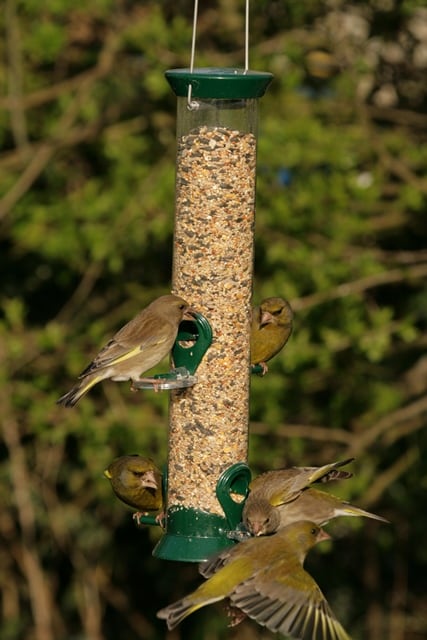
Perch rings slide over the steel perch of all our Droll Yankee feeders and not only forms a more comfortable feeding position for many birds, but also means that Robins can use the feeder.
Rain Guard
A rain guard what it says and will keep feeders dry – especially useful when it’s wet and windy (the wind can force water into the ports which makes the contents of the feeder wet and can clog it).
Super Link
If you’re pushed for space or just want to add another feeder to your Feeding Station but don’t have a spare arm for it, then a super link allows you to hook one feeder under another.
Garden Pole
Like the Feeding Station, the garden pole allows you to position feeders in your garden exactly where you want them. You can also add extra feeders to the Garden Pole with the wrap around hook.
See our full range of garden bird feeding accessories.
General Tips on Feeding Garden Birds
Ensure food is available at all times.
In years past, it was often believed that garden birds only needed feeding in the winter months. Now research proves that this isn't the case, and in fact feeding garden birds in the spring is just as important as in the winter, as natural food is often in low supply (certainly if it’s wet and cold) and the birds have their young to feed. So all-year feeding is the best approach to take, ensuring there are no gaps in-between. In other words if you commit to feed your garden birds, then it’s important that this is maintained on a daily basis. Why? Because birds will quickly become used to feeding in one place, and if they then fail to find food there they’re wasting valuable energy looking for another source.
Site feeders away from predators such as cats.
It’s been estimated that pet cats kill a staggering 55 million birds in our gardens each year, and the impact of this has had a bearing on the decline of many of our once common bird species. So if you have a cat, or a neighbour’s cat comes into your garden, it is absolutely vital to site feeders away from shrubs and other areas where cats can wait and pounce on birds.
Keep feeders clean and hygienic.
Ironically, it can be the feeding of garden birds which also kills them if feeders aren't kept clean and hygienic. However, if they are cleaned regularly then the risk of illness and disease is very minimal. See our page on "Hygiene" for more information.
Store all food in a cool dry place.
It’s important to store bird food properly to ensure it remains in the right condition ready for use. All foods can get mould growth if they’re not kept dry, plus seeds can also sprout if they get damp. So store all foods in sealed containers in a cool dry place.
Read our guide on "Food Storage" for more information.

